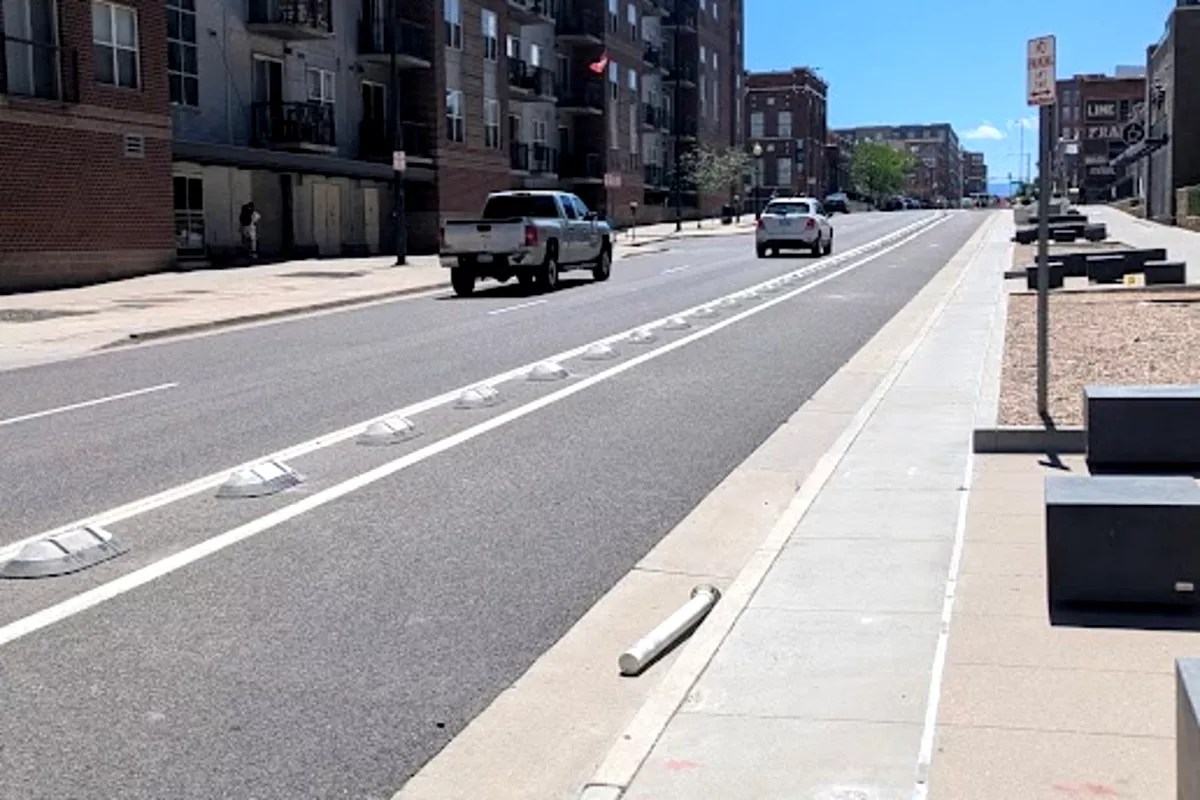
Rob Toftness

Audio By Carbonatix
Although it might not sit right with cyclists who feel exposed in bike lanes, the City of Denver is removing the short, column-like dividers known as flex posts in some neighborhoods and replacing them with speed cushions and small dividers for both easier maintenance and aesthetic reasons.
“The removal was a total surprise,” says Rob Toftness, a co-founding member of the Denver Bike Lobby advocacy group. “Removing protection for aesthetic reasons is a step backwards. Removing pieces of a successful lane that was already installed also seems unwise.”
The City of Denver is replacing flex posts on sections of Blake Street from 14th Street to Broadway, which is right in the middle of downtown and passes Coors Field. A block south, Market Street will also lose its flex posts from Speer Boulevard to Broadway.
Flex posts will also be replaced in the Montclair and Hilltop neighborhoods in central Denver.
The flex posts along Blake and Market streets are being replaced by very short dividers called Zippers that are only a few inches tall. The Zippers are made by the Spanish company Zicla, and are often called Ziclas, too.
Denver, make your New Year’s Resolution Count!
We’re $17,500 away from our End-of-Year campaign goal, with just a five days left! We’re ready to deliver — but we need the resources to do it right. If Westword matters to you, please contribute today to help us expand our current events coverage when it’s needed most.
When he saw city crews removing the flex posts earlier this week, Toftness began to worry that switching to smaller dividers would reduce security for cyclists in bike lanes. He argues that they’re too small to stop cars from parking in bike lanes or to help people see the lanes when it snows.
“It makes it way more inviting for bike-lane parkers,” he says about the Zippers. “We now lose guidance in the winter, visual friction to help slow drivers and activate their awareness and a small but added sense of protection.”
Flex posts are usually about four feet tall and much harder to miss or ignore, according to Tofteness.
On its website, Zicla says that the Zippers “discourage encroachment” into the bike lane and “make parking on the cycle lane difficult.” The company explains that Zippers do that by “creating a physical barrier,” but Toftness worries that cars will have no problem driving over these barriers if they really want to park in a bike lane.
Zippers and other products made by Ziclas are used in more than 400 cities worldwide, according to the company. Toftness knew about the company and its products before he saw them in Denver’s bike lanes, and he admits that the Zippers “are a unique product and much hardier than other solutions.”
But he still isn’t reassured by Zicla’s promises. Bike lane blockage is a growing problem in Denver, and it forces cyclists out into car lanes, where they’re more likely to get hit.
According to Denver Department of Transportation & Infrastructure communications director Nancy Kuhn, the city will leave flex posts alone in “locations that require greater visibility, such as corners, and places where people in cars and people on bikes are more likely to conflict.” She says the city is ditching flex posts to give that downtown area a better look and to make sure pedestrians can see into store windows from across the street. Zippers are also easier to fix, remove and replace, she adds.
“It is a design we believe will be easier to maintain based on feedback from our maintenance teams,” Kuhn says. “We’re continuing to provide protection and safe corridors for riding bikes and scooters, while enhancing overall aesthetics and improving sight lines for pedestrians, allowing people to see across the street better into store windows.”
In the summer, the city plans to start removing flex posts in central Denver along Kearney and Krameria streets from East 13th Avenue down to East Virginia Avenue. The transportation department finalized plans to make biking safer and easier along the corridor in April 2024 as part of the Kearney/Krameria Neighborhood Bikeway project.
The removal should be finished by the end of the year, according to DOTI, which will replace the posts with speed cushions. Similar to speed bumps, cushions are raised pavement sections with cutouts for emergency vehicles, bikes and scooters.
Kuhn says that DOTI studied speed cushions and found that they effectively slow down cars and require fewer signs. The cushions also “have no parking impacts and are frequently requested by residents citywide,” she adds.
The city will focus on removing flex posts along what are called pinch points (or chokers) that appear mid-block along the corridor. Pinch points are areas where the sidewalk or lanes for biking or parking widen and the road narrows, according to the National Association of City Transportation Officials. The idea with pinch points is that drivers will slow down once the road narrows, but speed cushions are designed to make sure they do by forcing them to hit a bump.
Speed cushions weren’t added to DOTI’s engineering guidelines until after the Kearney-Krameria bikeway project was approved, Kuhn says, so the city wants to go back and add them now that it’s confident in their effectiveness.
Scraping the flex posts on Kearney and Krameria streets and Blake and Market streets isn’t the end of the road, either. The city will consider similar “new/alternative bike lanes and safety treatments (such as speed cushions and ziclas) in other future projects,” Kuhn adds.